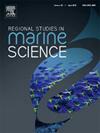巴拿马主要港口海上活动造成的空气排放的时间估计
IF 2.1
4区 环境科学与生态学
Q3 ECOLOGY
引用次数: 0
摘要
海上运输在全球范围内取得了显著增长,使其成为最有效、最安全的货物运输方式之一。然而,这种扩张也带来了负面后果,比如空气污染加剧。研究港口排放至关重要,尤其是在信息匮乏的发展中国家。本研究估计了2009年至2023年间巴拿马五个主要港口的排放量,旨在建立基线并评估标准污染物(二氧化硫、PM10、PM2.5、一氧化碳)和氮氧化物随时间的变化。排放量的计算采用了美国环境保护署的自下而上方法。此外,还分析了so2、PM10和PM2.5的三种燃料硫含量情景:3.5 % S m/m、0.5 % S m/m(当前情景)和0.1 % S m/m(潜在排放控制区情景)。结果表明,曼萨尼约港的排放量贡献最大,为36.92 %,其次是巴尔博亚港(20.22 %)、可可索罗北港(15.88 %)、克里斯托瓦尔港(13.71 %)和罗德曼港(13.27 %)。据观察,自2021年以来,90.81 %的排放量来自集装箱船。这表明,这是巴拿马海事部门的主要活动,其次是滚装船,其排放量约占9% %。总体而言,我们的研究结果表明,巴拿马港口的氮氧化物排放量低于国际港口。本文章由计算机程序翻译,如有差异,请以英文原文为准。
Temporal estimation of air emissions due to maritime activities in the main ports of Panama
Maritime transport has seen significant global growth, making it one of the most efficient and safest methods of moving cargo. However, this expansion has also led to negative consequences, such as increased air pollution. Studying port emissions is crucial, particularly in developing countries where information is scarce. This study estimates emissions from Panama's five major ports between 2009 and 2023, aiming to establish a baseline and evaluate changes in criteria pollutants (SO2, PM10, PM2.5, CO) and NOx over time. The bottom-up methodology of the U.S. Environmental Protection Agency was applied to calculate emissions. In addition, three fuel sulfur content scenarios were analyzed for SO₂, PM10, and PM2.5: 3.5 % S m/m, 0.5 % S m/m (current scenario), and 0.1 % S m/m (potential emission control areas scenario). The results show that the port of Manzanillo leads the contribution with 36.92 % of emissions, followed by the ports of Balboa (20.22 %), Coco Solo Norte (15.88 %), Cristobal (13.71 %) and Rodman (13.27 %). It was also observed that since 2021, 90.81 % of the emissions come from container ships. This shows that this is the predominant activity in Panama's maritime sector, followed by RoRo vessels, which contribute approximately 9 % of the emissions. In general, our results indicate that the Panamanian ports have lower NOx emissions than international ports.
求助全文
通过发布文献求助,成功后即可免费获取论文全文。
去求助
来源期刊

Regional Studies in Marine Science
Agricultural and Biological Sciences-Ecology, Evolution, Behavior and Systematics
CiteScore
3.90
自引率
4.80%
发文量
336
审稿时长
69 days
期刊介绍:
REGIONAL STUDIES IN MARINE SCIENCE will publish scientifically sound papers on regional aspects of maritime and marine resources in estuaries, coastal zones, continental shelf, the seas and oceans.
 求助内容:
求助内容: 应助结果提醒方式:
应助结果提醒方式:


